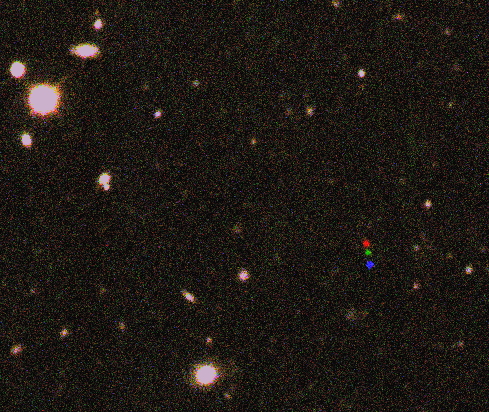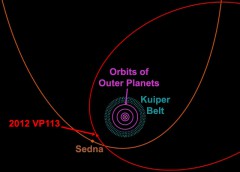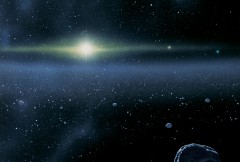
A team of astronomers has announced the discovery of a new dwarf planet candidate called 2012 VP113 at the outermost edges of the Solar System, possibly confirming the existence of the Oort Cloud, the hypothetical vast reservoir of trillions of icy minor planetary bodies where comets are thought to originate. More interestingly, this discovery leaves the door open for the possibility of a bigger, more massive planet orbiting beyond the known reaches of the Solar System.
With all the small, icy Solar System bodies being discovered during the last 20 years beyond the orbit of Neptune, you could be forgiven for not knowing exactly where the Solar System ends. For decades, it seemed like it was a neatly organized place, consisting of two distinct planetary families: the terrestrial planets (Mercury, Venus, Earth, and Mars) closer to the Sun, the gas giants (Jupiter, Saturn, Uranus, and Neptune) farther out, and an asteroid belt in between the orbits of Mars and Jupiter separating the two groups. And then there was Pluto, an oddball celestial body whose highly inclined orbit beyond Neptune and very small size made it look more like a rogue moon than a full-blown planet. Nevertheless, and despite this apparent observed tidiness, astronomers had theorised for years that the left-over material of the Solar System’s formation would have formed a vast belt of icy planetoids extending beyond the orbit of Neptune, in essence constituting a new, third class of Solar System objects which they called the “Kuiper Belt.”

The discovery of 1992 QB1 in 1992, a small object with a diameter of a few hundred kilometers, confirmed the existence of the Kuiper Belt and gave more credence to previously held notions among the scientific community that Pluto itself should not be considered a planet, rather a large member of a new class of objects orbiting in these distant reaches of the Solar System, called Kuiper-Belt Objects, or KBOs. The systematic discovery of thousands more of similar objects helped astronomers to determine that the boundaries of the Kuiper Belt extended from beyond the orbit of Neptune, 30 Astronomical Units from the Sun, to 50 AU away (1 AU is the average Earth-Sun distance, approximately 150 million km). Most importantly, the discovery of Eris in 2005, an object with a diameter the same as Pluto’s, forced the International Astronomical Union the following year to reclassify the then-ninth planet from the Sun as one of the largest members of the newly adopted “dwarf planet” category, alongside Eris and a handful of KBOs a bit smaller than Pluto that had been discovered in previous years.
One of these dwarf planets, named Sedna, caused quite a stir when it was discovered in 2003. Whereas the orbits of other dwarf planets like Pluto, Eris, Haumea, and Makemake were positioned inside the Kuiper Belt, Sedna’s orbit around the Sun was much more elongated, with an aphelion of 937 AU and a perihelion of 76 AU. This meant, according to many astronomers, that Sedna’s place of origin was the Oort Cloud, the hypothetical spherical cloud of trillions of comets and other icy planetesimals that envelops the Solar System and whose existence had been theorized by Dutch astronomer Jan Oort in 1950.
The recently discovered 2012 VP113 (affectionately called “Biden,” after the incumbent U.S. Vice President) is the second minor Solar System body besides Sedna to have such an elongated orbit. In fact, even though 2012 VP113’s orbit never brings it past 500 AU from the Sun, it nevertheless has a perihelion of 80 AU, even larger than Sedna’s.

The discovery and overall research work that was supported and partially funded by NASA was made by Chadwick A. Trujillo, assistant astronomer of the Gemini Observatory in Hawaii, and Scott S. Sheppard, an astronomer at the Carnegie Institution for Science’s Department of Terrestrial Magnetism, in Washington, D.C. Both researchers are no strangers to new Solar System discoveries, with Sheppard being the co-discoverer of many dozens of small moons around Jupiter, Saturn, Uranus, and Neptune, while Trujillo is most famous for being a co-discoverer of Sedna and more than a dozen Kuiper Belt Objects, such as Eris, Haumea, Makemake, and Quaoar. Trujillo and Sheppard first observed 2012 VP113 during November 2012, with the Dark Energy Camera, or DECam, mounted on NOAO’s 4-meter Víctor M. Blanco Telescope in Chile. They later used the 6.5-m Magellan telescope at Carnegie’s Las Campanas Observatory to track its orbit over a series of months and gathered more details about its surface features. “The detection of 2012 VP113 confirms that Sedna is not an isolated object; instead, both bodies may be members of the inner Oort cloud, whose objects could outnumber all other dynamically stable populations in the Solar System,” the researchers write in their study, titled “A Sedna-like body with a perihelion of 80 astronomical units” and published in the March 27 edition of Nature.
From their observations Trujillo and Sheppard calculated the object’s diameter to be no more than 450 km (approximately half that of Sedna) and consisting almost entirely of frozen volatiles, such as water, methane, and carbon dioxide. Although relatively small, it is possible that 2012 VP113 could have a round shape, thus qualifying as a dwarf planet candidate, according to Mike Brown, professor of planetary astronomy at Caltech and co-discoverer of Sedna and many Kuiper Belt objects: “Ice is not as hard as rock, so it less easily withstands the force of gravity, and it takes less force to make an ice ball round. The best estimate for how big an icy body needs to be to become round comes from looking at icy satellites of the giant planets. The smallest body that is generally round is Saturn’s satellite Mimas, which has a diameter of about 400 km. So somewhere between 200 and 400 km an icy body becomes round.”

Yet the most fascinating aspect of the study is its implications for the possibility of more massive, distant objects orbiting the Sun inside the unknown expanses of the Oort Cloud. The reason for such speculation is the greatly elongated orbits of Sedna and 2012 VP113 themselves, which means something must be altering them. There are currently three hypotheses that explain how objects within the inner Oort Cloud could be perturbed: by the gravitational effects of a star passing close to the Sun, by a rogue extrasolar planet captured by the Sun’s gravity, or by a massive Solar System planet, orbiting hundreds of Astronomical Units away from the Sun, inside the inner Oort Cloud. The latter, according to theoretical models, seems the most probable hypothesis. Studies have shown that the close passage of stars or rogue extrasolar planets near the Sun would not have any noticeable gravitational effects on the region where Sedna and 2012 VP113 reside. These effects would be much greater on the outer part of the cloud, which is thought to extend from roughly 1,500 to 50,000 AU away from the Sun. The elongated orbits of Sedna and 2012 VP113 could then best be explained by the presence of hundreds of more massive planetary bodies, according to the study’s authors. “Some of these inner Oort cloud objects could rival the size of Mars or even Earth,” says Sheppard. “This is because many of the inner Oort cloud objects are so distant that even very large ones would be too faint to detect with current technology.”

Searches for these distant objects have been ongoing in recent years. As detailed in a recent AmericaSpace article, NASA’s Wide-field Infrared Survey Explorer, or WISE, conducted two all-sky surveys at infrared wavelengths, with a sensitivity strong enough to detect a Jupiter-sized planet out to 26,000 AU and a Saturn-sized planet out to 10,000 A.U. Yet WISE found no traces of any such planets. But if the hypothesized objects in Trujillo’s and Sheppard’s study were smaller than Saturn, they would have been unobservable by WISE. Ultimately, the authors state that more objects similar to 2012 VP113 need to be discovered so that astronomers can better understand which model of the Oort Cloud’s evolution best fits the observations: “Each theory of inner Oort cloud object formation predicts different orbital configurations for the population. Therefore, as more inner Oort cloud objects are discovered, their orbits will provide strong constraints on the inner Oort cloud object formation models and thus our Solar System evolution.”
Despite being highly speculative, the notion of an undetected massive planet lurking somewhere inside the inner Oort Cloud makes the vast expanses lying beyond the orbit of Neptune much more interesting than previously thought. “The discovery of 2012 VP113 shows us that the outer reaches of our Solar System are not an empty wasteland as once was thought,” says Trujillo. “Instead, this is just the tip of the iceberg telling us that there are many inner Oort Cloud bodies awaiting discovery. It also illustrates how little we know about the most distant parts of our Solar System and how much there is left to explore.”
Currently, NASA’s New Horizons spacecraft is on its way to become the first ever man-made object to study Pluto and its moon, Charon, in July 2015. It is hoped that following the Pluto encounter, the spacecraft will continue on its journey while studying more objects within the Kuiper Belt, revolutionising our understanding of this largely unexplored region of the Solar System along the way. The exciting discovery of 2012 VP113 opens up a whole new realm of the Sun’s family for further, more detailed study.
What else is out there to explore? NASA, the ball is in your court now.
Want to keep up-to-date with all things space? Be sure to “Like” AmericaSpaceon Facebook and follow us on Twitter: @AmericaSpace




Upon reading such very well-written, intriguing works as this Leonidas, I find myself wondering, “With such fascinating, mysterious, exciting discoveries about the very solar system in which we live being made, and to be made, how can the general public be so lethargic, uninterested, and Honey Boo-Boo Miley Cyrus fixated? A new book, “Marketing The Moon” is out which highlights the “selling” of the Apollo program. NASA is absolutely INCREDIBLE, and Americans need to be continually, effectively informed of this fact. The ball is indeed in NASA’s court, but NASA needs an educated enthusiastic very supportive public if it is to accomplish the planetary science exploration miracles that it can perform if given the chance. Great article Leonidas! Keep fighting the good fight my friend! 😀
You’re right Karol, NASA is indeed incredible and the more people realise that the better. Yet, there will always be an uninterested and lethargic part of the general public about NASA’s role and overall magnificent space accomplishments. What the space agency needs in order to explore, is a capable and strong leadership amongst other things.
I am so enraged with Bolden’s comments about the SLS/Orion, at the recent Congressional hearing concerning NASA’s FY15 budget. Bolden is a generally likeable person, yet I couldn’t believe I was hearing him testify that if he faces any problems with the Russians concerning US astronaut access to the ISS, he will go to the White House and propose that the SLS/Orion be cancelled!
The current NASA and White House administrations are well on their way to go down in history as the worse and most destructive ever, regarding US space policy. I really can’t wait for the day of the 2016 presidential elections, when both will be escorted out the door.
If the current political winds continue, there is a very real chance that the November 2014 mid-term election will see a change in the Senate, and with the Republicans in control in both the House and Senate, the likelihood of the White House being able to sneak through another Constellation cancellation under the watch of Stonewall Shelby is not very good. Nevertheless, it would be wonderful if NASA had leadership as intelligent as it’s dedicated rank and file workers. The dedicated brilliant NASA workers, as well as the devoted space advocates, deserve better than “hopefully it will be better after 2016”. I share your anger Leonidas, you’re exactly right. So much space exploration could be achieved but for . . . .
Bolden, while likable as a person, has more or less lost all credibility on the Hill. His comments last year about never leading a Moon landing pretty much cratered, pun intended, any goodwill he had on Capitol Hill. His latest comments last week are just more icing on the cake. His running-of-the-mouth just may have put back into play HR 3625, which I doubt was Bolden’s intent. HR 3625 would prevent the NASA Administrator from canceling SLS, Orion, and JWST and release all funds being currently withheld from those programs for termination liability.